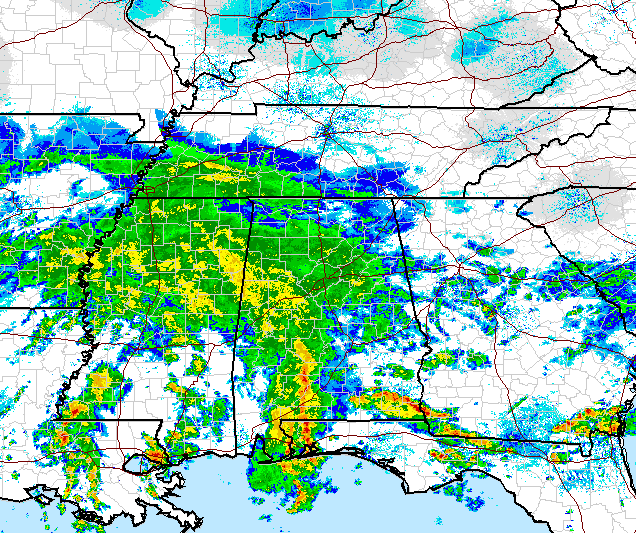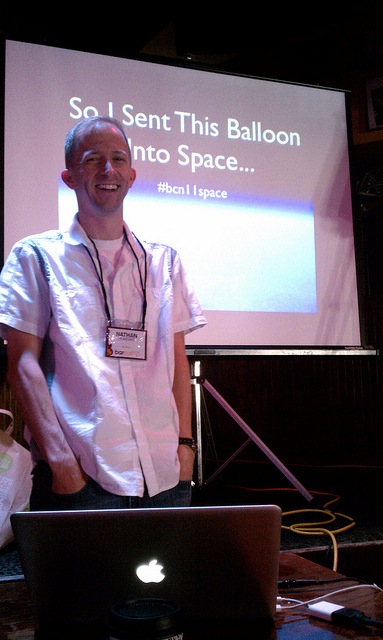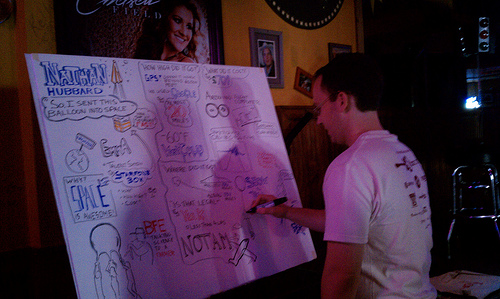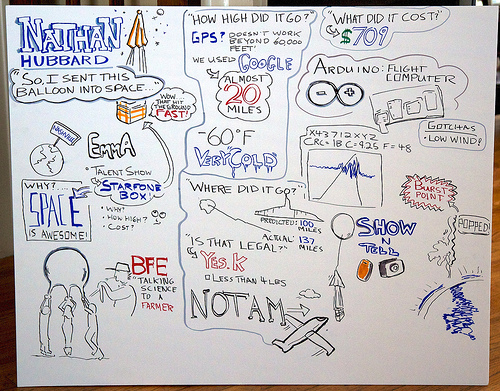Thoughts on "negative-Kelvin"
Nature: Quantum gas goes below absolute zero.
I thought I had a decent understanding of physics. But after reading this, someone should revoke my 'amateur scientist' card. This (from Wikipedia) helped me understand it:
Since we started with over half the atoms in the spin-down state, initially this drives the system towards a 50/50 mixture, so the entropy is increasing, corresponding to a positive temperature. However, at some point more than half of the spins are in the spin-up position. In this case, adding additional energy reduces the entropy, since it moves the system further from a 50/50 mixture. This reduction in entropy with the addition of energy corresponds to a negative temperature.
This is not about the common notions of hot and cold, this is thermodynamic temperature, which is about entropy and energy. OK, so to me, this amounts to a neat physics trick. The universe will not collapse and our understanding of physics hasn't changed. Hopefully, it'll inspire a few folks (like me) to understand it better. Doing more reading, it reads like this only works in a 'system' of atoms, not with a singular atom. If you can't make a single atom colder than 0.0 kelvin, then the fundamental physics models don't change. Somewhat frustratingly, I see no mentions of anti-gravity, which was the most radical thing said on the nature.com article. So, please erase that and any anti-gravity belt predictions from your memory banks.
Speaking of theoretical maximums, another fascinating one is the concept of "absolute hot", which is currently defined as the Planck temperature, (1.416785×10^32^ kelvin). All physics models break down, even things like gravity. And, theory says that the entire universe has already experienced this temperature, a fraction of a second after the big bang. Enjoy that thought.
Further reading:
High-Speed Datacenter Work
Went to the datacenter last night to build out a few DB servers with 64GB of RAM. And set up a timelapse to record parts of the work. Marc, Brian and I did 2 servers each. You can see some up-close shots of the Dell R710 hardware, though it's quite blurry. Playback is 74 x normal speed.
Wasp Nest
Found a paper wasp nest today while we were having work done on the house. It was cold out and I thought they were dead...when I set it down in the sun to take a picture, I saw some movement. So, I filmed the little guy trying to get out. National Geographic here I come.
Rain Math
The storm headed our way tonight is predicted to drop 2" of rain over Nashville. If it covers the entire 527 square miles with that amount (on average), that storm would drop 152.8 billion pounds of water. Yay science.

Here's my math:
1 inch of rain x 1 square mile = 65,785 cubic meters = 17,378,742 gallons
Nashville is 527 square miles according to Wikipedia.
A gallon of water weighs 8.35 lb.
So, 2 inches of rain over every inch of Nashville is 2 x 527 x 17,378,742 ....
Which is 18,317,194,068 gallons. Which weighs = 152,948,570,467 lb.
Yikes. I better go start mowing the yard like right now. I don't want to get killed when the rain falls on me
git + sudo + local ssh keys
Some colleagues and I wanted to be able to check out code onto a remote server using our local github ssh keys. And we should be able to do that as any user we please (for example, the deploy user). After a bit of research, I found that it's possible! In short, you use ssh-agent to pass your key credentials on to the remote server and set up sudo to pass those credentials along thru the environments. Let's do this!
I'm on a Mac, which has ssh-agent running by default. Yay! But, you still want to verify that your key is added to the agent:
laptop:~ n8foo$ ssh-add -l
2048 00:00:00:00:00:00:00:00:00:00:00:00:00:00:00:00
/Users/n8foo/.ssh/id_rsa (RSA)
Now, ssh into your remote server using the -A flag to ssh to pass auth along.
ssh -A remoteuser@remote.server.com
Test that ssh's agent auth worked:
[remoteuser@remote ~]$ ssh-add -l
2048 00:00:00:00:00:00:00:00:00:00:00:00:00:00:00:00
/Users/n8foo/.ssh/id_rsa (RSA)
Your keys should show up. Now, confirm that you can access github with your key from that remote server:
[remoteuser@remote ~]$ ssh -T git@github.com
Hi n8foo! You've successfully authenticated, but GitHub does not provide shell access.
OK, now let's enable this so we can switch users with sudo. Sudo needs to pass the SSH_AUTH_SOCK environment variable on through. To do that, add (or modify) the defaults line in /etc/sudoers to look something like this:
Defaults env_keep+=SSH_AUTH_SOCK
You can do this, if you have a default ubuntu sudo config:
# sed -i "s/^Defaults.*/Defaults env_keep+=SSH_AUTH_SOCK/g"
/etc/sudoers
Everything should be working now. Let's test...
[remoteuser@remote ~]$ sudo su - someotheruser
[someotheruser@remote ~]$ ssh -T git@github.com
Hi n8foo! You've successfully authenticated, but GitHub does not provide shell access.
You can now get your git on, directly on your remote machine, as another user. Done!
BCN11 Wrap-Up
My Space Balloon presentation at BarCamp Nashville went well. I normally would 'wing' a BarCamp talk, showing only the pics/video or show-n-tell. But I realized earlier in the week that I had a lot to cover and only 35 minutes to complete it. I figured some organization of my material might be in order. So, those of you that were there got to witness my first ever keynote presentation. Woo hoo!
I had a number of people tell me that they missed it, due to collision with blocked-off roads from a footrace that morning or the 9AM timeslot. So, here is the presentation in PDF format, with movies removed: Space Balloon BCN11 Presentation. If you want to see the movies, they are linked on my blog here.
One other really cool thing that happened yesterday during the talk was Nick Navatta drawing a graphic of the presentation. Seriously cool. He even let me keep the end result, which I shot and put up on flickr.
Here is the full pic:
Nashville Amazon Web Services User Group
A few of us are putting together a local Amazon Web Services User Group here in Nashville. The initial idea is to follow a format similar to Portland's AWSUG. Invite local experts, give talks, get together and share stories, etc. Maybe host a yearly event in Nashville, not sure. These are all just ideas at the moment. AWS's most game-changing (and also complex) product is EC2 and I'm guessing that will garner a lot of interest. That's also my area of expertise and interest.
Scheduled for Wednesday, Sept 28th (2 weeks from yesterday), the first meet up would be an informal get together to come up with a simple charter, brainstorm on activities, come up with a list of potential venues and sketch out a general calendar for the next quarter. I figure this can be accomplished after work, across a table of drinks. Yeah?
If you'd like to join....we'll be at the Corsair Taproom from 6pm till about 8pm.
Nashville Amazon Web Services User Group (NAWSUG)
Initial Planning Meeting - Informal w/beer
Sept 28th 2011, 6pm-8pm at the Corsair Taproom
Corsair Taproom Location:
1200 Clinton Street #110
Nashville, TN 37203
615-321-9109
Map
Link
BarCamp 0b10
There's been a flurry of activity in Nashville about Bar Camp over the last 48 hours...and 5 years. I won't summarize because it removes the passion. If you care, go read them (referenced at the bottom).
So what do we (the Nashville community) do about it. Well, we act. Earlier today Tim Moses posted this:
I think there is room for an alternate BarCamp that answers your concerns without conflicting with the current BarCamp. BCN may not be true BarCamp format, but it is successful. It may not be tech-heavy, but that seems to be improving in large part by the BCN organizers. Making dramatic changes to BCN would most likely hurt it more than help.
The problem isn't with the existence of BCN or how it operates, but the nonexistence of a tech-focused BarCamp. Many BCN supporters have repeatedly suggested an alternate, but no one has stepped up to do it.
On that note, Nathan Hubbard (ex-Telalinker with true BarCamp experience), and I are organizing BarCamp 0b10, a tech-focused, 2 day, traditional BarCamp to complement BCN. The current plan is to space it far enough from BCN (maybe Spring) to not force a choice between the two. If you like both, go to both, present at both. If not, pick your BarCamp of choice.
We're shooting for a date sometime this spring and looking to things like this and people like this for inspiration and guidance. Initial thoughts are: traditional BarCamp, 2 days (camping!), complimentary to BCN, 'tech focused' but not tech only, simpler and less complex, less organized, etc. Tim and I will announce more via this blog and our twitter accounts (@timmoses, @n8foo) in the next few months. Keep your eyes peeled. Update: we have a new twitter account: @BarCamp0b10 and hashtag #0b10.
Right now, the Nashville community needs to focus on making BarCamp Nashville 2011 awesome. Go sign up. Go to make a difference. Go to see what it's like if you've never been. Don't wait on our event, go act.
References:
- Nashville Scene: BarCampNashville Descends Into Online BarFightNashville
- Chris Wage: The Not-So-Great Barcamp Schism
- Matt George: Clarification on BCN comments
- Twitter: BCN_Critic
- Countless posts on twitter by the Nashville BCN crew and other tech heavyweights.
- Bar Camp Nashville
- The Rules of BarCamp
- BarCampSD
Space Balloon Post Launch Wrapup
SPACE

The image above is a picture taken at 102,000 feet over Nashville back
in April, from our Space Balloon.
Yep, the balloon launch back in April was a success. As was the presentation that Marc, Jared and I did at Emma Talent Night. It was actually far better than I could have imagined. We kept the whole project a secret right up until the night of the show. For weeks, people were watching us tossing parachutes out windows and messing with flashing lights and cameras. It really built up some great suspense. By the time the night finally arrived for the big reveal of our 'talent', the audience was actually chanting "SPACE! SPACE! SPACE! SPACE!". It was epic, really, for a bunch of nerds to get up and talk about sending a balloon to space in the middle of 2 dozen other awesome music, singing, magic and other acts. And get cheered at during the process. While drinking. Truly one of the most awesome things I've ever done.
Enough gushing, down to the data.
This data was recorded by our flight computer, an on board micro Arduino with 2 different sets of 1-Wire temp and barometric sensors and a 3-way gyro.
Avg ascent rate: 4.89 m/s (10.9 mph)
Avg ascent rate first hour: 2.32 m/s (5.19 mph)
min temperature : -59.116 F
max altitude : 102,496 ft (19.4 mi)
min air pressure : 930pa (0.93% surface)
max descent rate : 245 mph
-59 F! Wooo wee that's cold! The 245 mph speed was with the chute open! See, the air is so thin up there that even with the chute open it was screaming towards earth. At more reasonable altitudes, it slowed down to a more lazy pace of 15 mph. The height we achieved was 102.5K feet. That's almost 20 miles! One of our other calculations shows 106k feet so it was in that range somewhere.
On to the videos and pictures:
This is what we showed at the talent show after we got up and gave our talk about the balloon, more of a quick documentary of the process. It always makes me laugh watching our first two parachute drop tests. Especially on the second one when Pamela laughs at us. Music courtesy of 84001 (my co-worker Jimmy's band).
This is the music video I put together for 84001, to be shown while they played live music on stage. It's various trippy time lapse and spacey stuff and about 10 minutes of balloon footage that starts around the 2:20 mark and the burst occurs at around 7:10...the music in this video is basically the same set they played live. The 3 cameras in the balloon filmed a total of 8GB of data across 3.5 hours, of which you are seeing less than 2% here:
More pictures, on Flickr with some video as
well:http://www.flickr.com/photos/n8foo/sets/72157625894886863/
The actual slideshow, complete with graphs and stuff, from the
Presenation: http://www.youtube.com/watch?v=R_aiON0-2J8
Thanks to Marc and Jared for making this a super kick ass fun science project. I can't wait for the next one. :-)
tcpdump web traffic
Want to tcpdump your web traffic for debugging? Here's the formula I've been using lately:
tcpdump -s 1514 -Ai en0 'tcp port 80 and tcp[((tcp[12:1] & 0xf0) >> 2):4] = 0x47455420'



